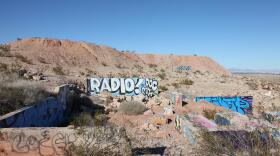What do you call the design style of this underground house? Subterranean Modern? Paranoidism? Suburban Apocalyptica? Maybe Cold War Just-In-Case-ism? This underground home — a legendary if largely unseen feature of the Vegas Valley cityscape — was built in the late 1960s by Avon founder Girard Henderson. Like many Americans at the time, Henderson shuddered to imagine a nuclear holocaust raining destruction on the U.S. Unlike most Americans, however, Henderson could afford to do something in case the unthinkable happened. On Spencer Avenue just north of Flamingo Road, he built what might be called a luxury fallout shelter, a $10 million, 16,500 square-foot subterranean spread that could ostensibly survive a Bolshevik bombing — in style and comfort. It came complete with its own underground generator and fuel tank, an “outdoor” backyard with fake trees and artificial turf, heated swimming pool and hot tub, and a computerized lighting system that cycles “day” and “night.”
Henderson was not alone in building against the threat of the bomb; in fact, the home’s protected “ship-in-a-bottle” design was inspired by builder Jay Swayze, who had even founded a company, Underground World Homes, dedicated to protecting (rich) people from what Swayze saw as probable nuclear war and an uninhabitable planetary surface. But — perhaps fortunately — no mass market ever materialized for deep-dig digs, and the company disbanded in the mid-1960s. Henderson’s underground house remains, however, now in a different age with different worries and fears. Which raises the question: Maybe it’s nuke-proof, but can it withstand a zombie apocalypse? (sources: Los Angeles Times, UNLV Special Collections)







